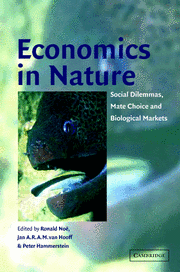Book contents
- Frontmatter
- Contents
- List of contributors
- Preface
- Acknowledgments
- 1 Games and markets: economic behaviour in humans and other animals
- Part I Economic behaviour in social networks
- Part II Biological markets
- 5 Biological markets: partner choice as the driving force behind the evolution of mutualisms
- 6 The utility of grooming in baboon troops
- 7 The cleaner fish market
- 8 Modelling interspecific mutualisms as biological markets
- Part III Mating markets
- Index
6 - The utility of grooming in baboon troops
Published online by Cambridge University Press: 04 August 2010
- Frontmatter
- Contents
- List of contributors
- Preface
- Acknowledgments
- 1 Games and markets: economic behaviour in humans and other animals
- Part I Economic behaviour in social networks
- Part II Biological markets
- 5 Biological markets: partner choice as the driving force behind the evolution of mutualisms
- 6 The utility of grooming in baboon troops
- 7 The cleaner fish market
- 8 Modelling interspecific mutualisms as biological markets
- Part III Mating markets
- Index
Summary
Periodically through the day – most obviously early in the morning and late in the afternoon – an individual member of a wild baboon group will approach another and begin to comb meticulously through its pelage with dextrous fingers or, equally likely, solicit such behaviour by lying down in front of the other animal. Such grooming, for other monkeys and apes, as well as baboons, is the defining act of sociality. Its dynamics are therefore likely both to reflect current ecological circumstances and to illuminate historical selection for attributes that enable successful performance in the social world. The broad question then, with which to begin, concerns the function of grooming.
To the observer, two things are immediately apparent. First, grooming clearly has hygienic value, since an animal also puts effort into grooming itself and because the grooming it receives from others is directed at those parts of its body that it cannot easily reach (Barton 1985). The targets of this grooming are ectoparasites, such as lice and their eggs (Saunders 1988; Tanaka & Takefushi 1993). The diligence and concentration that groomers apply to this task underscore the fact that grooming is more than just a pretext for tactile contact. Nevertheless, the second observation is that this physical contact is manifestly pleasurable for the recipient; it is, in fact, associated with the increased production of β-endorphins (Keverne et al. 1989). Presumably, this hedonistic benefit is a derived feature and serves, proximately, as the primary reinforcer sustaining participation. The analysis of function cannot, however, end here.
- Type
- Chapter
- Information
- Economics in NatureSocial Dilemmas, Mate Choice and Biological Markets, pp. 119 - 145Publisher: Cambridge University PressPrint publication year: 2001
- 32
- Cited by

